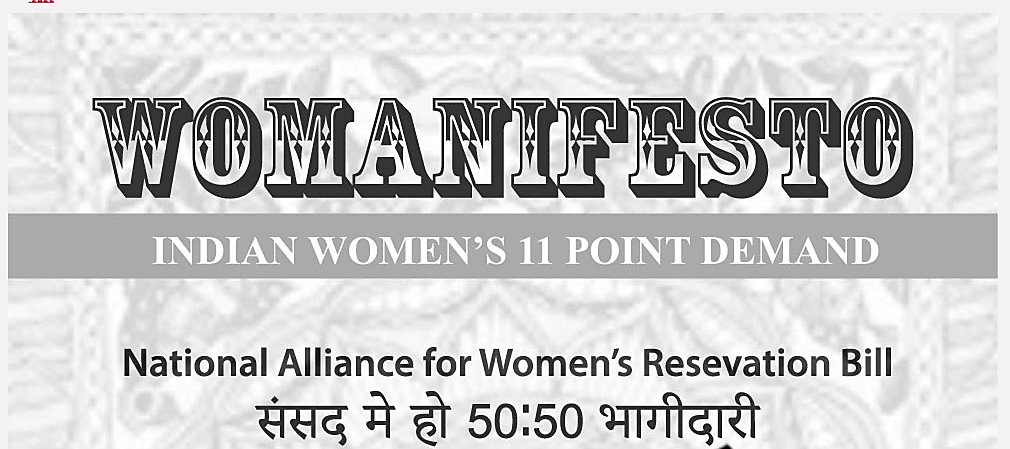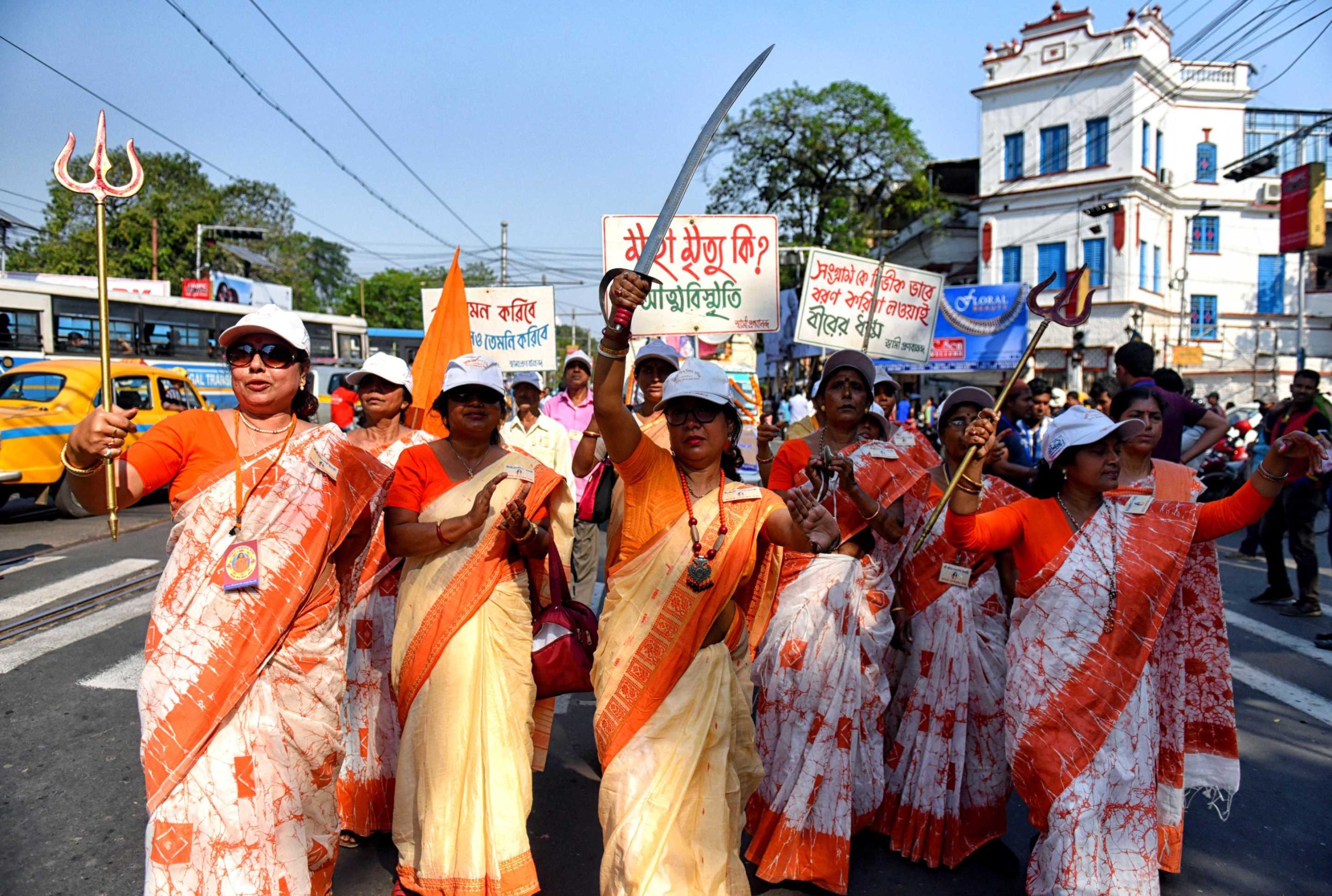Centre for Social Research (CSR), a Delhi based non-profit organisation working with the Indian women’s movement, published a Womanifesto ahead of International Women’s Day last month. CSR also heads the National Alliance of Women’s Organizations, a coalition of over 1,500 rights groups and activists across India. The alliance came up with the 11-point plan – “drafted after talks with hundreds of thousands of women, charities and gender experts.” The manifesto is an appeal to contesting political parties to incorporate the listed demands in their election manifestoes; it claims to represent Indian women’s demands but ultimately ignores the heterogeneous, varied demands of a people who have been oppressed and marginalised from within the community.
Highlights
The manifesto starts with a series of statistics like the high maternal mortality rate and the low female literacy and employment rate. It then categorises the demands into eleven separate sectors. These sectors are Health, Education, Equality for Women in Legislation, Leadership and Political Empowerment of Women, Gender Budgeting, Gender Mainstreaming, Monitoring and Evaluation, Environment, Special Schemes for Marginalised and Excluded Women, Livelihood and Employment Generation, Women’s role in Peace Process.
It rightfully stresses on women’s participation in politics (or lack thereof) as India ranks 20th from the bottom in terms of representation of women in Parliament. “The Election Commission must make some rules that unless you have at least 33 percent (female) members, you cannot qualify (for elections),” Ranjana Kumari, director of CSR, told Reuters.
While we wait for the BJP manifesto, it must be stated that all political parties must consult women’s and queer rights organisations for policy-making.
Apart from this, the manifesto pitched for setting up peace keeping committees with 50% female representation. “For resolving internal or external conflicts, in all peace committees at least half the members of such committees should be women, because women are the biggest sufferers of conflicts, aggressions or war.” This is an urgent stipulation during the uneasy India-Pakistan political climate today. The fact that sexual violence against women is used as weapon of war is often neglected; they are the biggest victims of all violence.
(Not so high)lights
The manifesto has no mention of LGBTQIA+ rights. For an organisation that claims to actively work towards gender justice, this exclusion cannot be ignored (or forgiven). To necessarily dismantle the Kyriarchy, the Indian feminist movement must include queer rights; it must go beyond elitist urban spaces and make space for women and non-men. As writer Flavia Dzodan very eloquently puts it in her 2011 blog post, “My feminism will be intersectional or it will be bullshit.”
Also read: Women And Minorities: Here’s What The New Congress Manifesto Has to Say
If one is to critically analyse the Womanifesto, there are several aspects that strike out to me as strange. While there is a point that demands free treatment to acid attacks victims, it ignores the need for stricter sale and storage laws for acid. The Supreme Court banned the sale of acid in 2017 but it is still easily available in most general or pharmaceutical stores. Similarly, all political parties have steered clear of the issue of women’s entry to Sabarimala, probably to appease their voter base. This was a great opportunity to demand accountability from these political parties to ensure safe passage of all women and Trans people into the temple.
One out of eleven sections is solely dedicated to marginalised and excluded women, the wording of which is quite vague and dismissive. SC/ST, single women, widows and differently abled women have all been put down in one single file when they all face different kinds of oppression. Compared to other sections that provide a plan of action and cite constitutional acts and laws, this section seems to be only put in to come across as #inclusive; it is tokenistic behaviour.
Response
On the 2nd of April, Congress came out with its own manifesto. This too has an entire section dedicated to ‘Women’s empowerment and Gender Justice.’ Although these are just promises made by the opposition a week before the election and must be taken with a pinch of salt, some of the demands from the Womanifesto have been taken into account. These are proper sanitation, adequate women representation in politics and crèche facilities.
Is It Enough?
A similar “Womanifesto” was released ahead of the 2014 elections, which saw Bhartiya Janta Party (BJP) win by the largest parliamentary majority in three decades. Although, this year’s manifesto is more thorough, both of them list similar demands for economic growth, safety and empowerment of women.
For an organisation that claims to actively work towards gender justice, the exclusion of Queer issues cannot be ignored (or forgiven).
It is clear that we still have a long way to go before achieving any form of gender justice in India. Most of the demands listed in it are rudimentary and it is lamentable that women have to request political parties to promise these basic rights to them.
Women turnout during India’s 2014 parliamentary general elections was 65.63%, compared to 67.09% turnout for men. While we wait for the BJP manifesto, it must be stated that all political parties must consult women’s and queer rights organisations for policy-making. Women’s organisations, on the other hand, need to conduct responsible research work in order to be more inclusive.
Also read: National Manifesto Released By Grassroots Muslim Women Activists
Like the Womanifesto demands, if gender is incorporated as a measure of development for all programs and schemes, then achhe din is nothing more than a distant dream.
Featured Image Source: CSR
About the author(s)
Srishti is a media student at TISS, Bombay. The best compliment she's ever received is "Madam, you write well and all but aap poori zindagi single rahoge"




